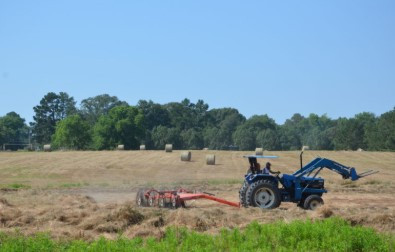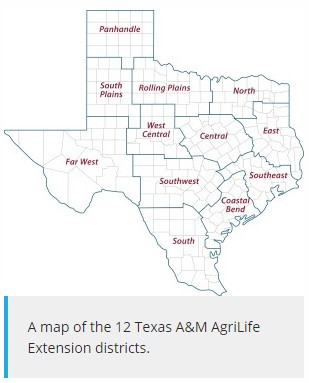By Adam Russell
Texas’ hay season has been a mixed bag for producers with results heavily dependent on Mother Nature and timing, said Texas A&M AgriLife Extension Service experts.
Vanessa Corriher-Olson, Ph.D., AgriLife Extension forage specialist, Overton, said conditions for hay production have been good in East and Central Texas with decent rainfall, though moisture has been scattered.

First-cutting conditions
Most hay producers have made their first cutting to clear cool-season grasses for warm-season forages, she said. The first cutting is typically one of the best regarding total digestible nutrients because, many times, it is a mix of ryegrass and warm-season grasses.
Producers who were able to access pastures likely made good first cuttings and are set up well for a good second cutting. Some may be making a second cutting soon, if not already.
“It should’ve been a good first cutting for producers who were able to cut and bale a few weeks ago,” Corriher-Olson said. “But many producers are having to work between rains, and that can be difficult when you’re cutting and need to let it dry down before baling.”
Corriher-Olson said a few producers cut pastures that received surprise showers before the hay could be baled. Sitting in the field for days reduces the nutritive value in the forage.
Scattered rain has left some areas soaked while others remained relatively dry, she said. Wood County reported 7 inches during one recent storm front while areas in nearby counties received trace amounts.
Soggy pastures have led to delays of pasture maintenance like fertilizer and/or herbicide applications and timely cuttings, she said. Timely cuttings can make or break nutritive quality as well.
“There’s a window for cutting to get peak nutritive value; that window of time can be species specific,” Corriher-Olson said. “Rain delays can push pastures past their prime.”
Warm-season weeds were becoming an issue for producers, she said. Continued wet conditions could exacerbate those problems. They could also delay fertilizer applications that would help maximize production.
Below normal nighttime temperatures in May might have delayed some growth as well. Bermuda grass performs best if nighttime temperatures are above 60 degrees consistently, and soil temperatures are 65 degrees or warmer.
“Cool nights with temperatures in the low 50s were not ideal and may have slowed growth, but I think a lot of areas had soil temperatures at or above 65 degrees, and I think that factors into growth enough to negate low nighttime temps,” she said.
Corriher-Olson said producers who can access pastures should be spraying for weeds and fertilizing to maximize production. But they should also be preparing for Bermuda grass stem maggots to arrive earlier than usual.
“We’re still a ways out for stem maggots,” she said. “They usually arrive around early July, but I’ve seen reports of early infestations in southern Georgia, and those conditions usually align with what we will see.”
South Texas and the Coast
Josh McGinty, Ph.D., AgriLife Extension agronomist, Corpus Christi, said conditions were very poor for forage production until two weeks ago when a soaking rain arrived to much of southeastern Texas up to San Antonio.
Many producers made fertilizer applications ahead of forecast rain, but the rains never came, he said.
The Texas A&M AgriLife station in Corpus Christi recorded around 2 inches of rainfall in 2020 before a recent rain, and McGinty said the number was from many small rains that likely evaporated. But the station recorded 2.3 inches of rainfall from one rain event last week, and more rain was forecast.
“It was the first soaking rain since last fall,” he said. “We will need more, but that rain will change things for a lot of pastures.”
McGinty said the soil moisture profile for spring and early summer forage production is usually set up by fall rains, but they didn’t materialize. Growing conditions for forages will improve quicker than for row crops, especially if rain in the forecast arrives.
Conditions in some fields are still too wet to apply fertilizer, he said.
“Some producers made a second application of fertilizer just before the recent rain, and should be doing well right now,” he said. “Others are applying fertilizer where they can in the hopes that these storms deliver another good soaking rain. If they get their pastures fertilized ahead of these rains, they should be set up nicely through June.”
AgriLife Extension district reporters compiled the following summaries:
CENTRAL
Good rain was reported in some areas. Soil conditions were wet in many areas. Cattle prices were still down. Corn in drier areas was not doing well, and many fields were at different growth stages. Corn fields with moisture were progressing nicely amid warm temperatures. Recent rains should help rangeland and pasture conditions and get hay fields growing again for a second cutting. Some farmers were able to start grain harvest. Livestock were in good condition. Small grain harvest started, and yields looked promising. A big rain was in the forecast, so producers were trying to apply fertilizer. Aflatoxin protection was applied to corn. Producers sprayed pastures and crops for weeds. Hay was cut and baled, and producers were harvesting wheat and oats. Cotton was emerging, and most grain sorghum was late planted, but emerged and was off to a good start. Water tanks were full.

ROLLING PLAINS
Several storms delivered beneficial moisture to most of the district. Some areas received up to 4 inches of rain. Area producers continued to prepare for winter wheat harvest though some fields showed freeze and hail damage. Producers prepared fields for spring crops. Cattle producers continued to provide supplemental hay where forages were limited.
COASTAL BEND
Much-needed rainfall was received, with amounts ranging from 1-3 inches. Some areas reported up to 8 inches of rainfall. Rains may be a little late to benefit the corn crop, but cotton and grain sorghum yield potentials improved. Rice farmers continued with aerial weed control applications. Rice producers were able to reach the flood stage. Weather permitting, wheat and oat harvest should be complete soon. Some haymaking took place. Fertilizer and herbicide applications continued on pasture and hay fields as weather allowed. Rangelands and pastures started greening and growing and were much improved compared to the last reporting period. Livestock were doing well, but prices were disappointing.
EAST
Rain fell across the district. Some counties received as much as 6 inches while others received scattered showers. Sabine County reported bottom lands remained too wet for any type of fieldwork. Producers in other areas were able to cut and roll hay. Pasture and rangeland conditions were good. Subsoil and topsoil conditions were adequate. Warm season grasses were greening up and growing. Producers began to gear up to spray warm-season weeds. Squash, peppers, green tomatoes, new potatoes and onions continued to be harvested. Growers planted a second round of peas. Wheat harvest looked good. Livestock were in good condition. Cattle prices remained unstable. Anderson County reported producers were looking for ways to control flies on cattle. Wild pigs were a major problem in croplands, hay meadows and pastures.
SOUTH PLAINS
The district received rainfall, and totals ranged from trace amounts in the northern parts to as much as 1.3 inches in the central parts of the district. A few farmers planted irrigated cotton, and others were waiting for soil temperatures to rise. Corn started to emerge, and some producers were pre-irrigating fields to get ready for planting. Cattle were in good condition.
PANHANDLE
Northern parts of the district reported adequate topsoil and subsoil moisture. Central areas were short on topsoil and subsoil, while southern areas reported very short subsoil and topsoil moisture levels. Pastures, rangelands and winter wheat were in poor to good condition. Wheat was headed out, and corn had been planted and was in good condition. Cotton planting was progressing.
NORTH
Topsoil moisture levels were mostly adequate with some reports of surplus moisture. Thunderstorms brought varying amounts of rain, with some areas receiving 1.25-4 inches of rainfall. Winter wheat was doing well and was starting to turn. Corn experienced substantial growth following rains. Cotton was up and doing well, and early planted beans looked good. Most ryegrass pastures were starting to thin. Hay producers were baling as much as they could. Rain was in the forecast and was expected to slow the baling progress. Livestock were in good condition. Pasture weeds were emerging.
FAR WEST
Temperatures ranged from daytime highs in the high-90s to nighttime lows in the mid-50s. Precipitation averaged between 0.25-5 inches. Hail damage and high winds reportedly caused damage to crops, property and out buildings. Cotton planting started to pick up where there was enough moisture. Many fields do not have enough moisture to plant, and irrigated fields were having a hard time delivering water below the soil surface. Dryland fields were too dry to plant cotton. Chinch bugs were reported in the Clint area. Corn and sorghum were holding on and looked decent. Watermelons were starting to take off. Alfalfa looked good. Pecan trees were doing well as producers continued to monitor pecan nut casebearers. Some pecan orchards were spraying zinc. Livestock conditions remained fair. Ranchers continued to rotate pastures with weaned calves and cows. Some producers pulled their bulls from the cows as well. Pasture conditions worsened by the day in dry areas.
WEST CENTRAL
Scattered showers were reported. Farmers were waiting for rain to plant cotton. Corn and sorghum were doing well. A few wheat fields that were not grazed out or baled for hay were nearing harvest. Calf prices were $5-7 per hundredweight higher, and prices on packer cows/bulls were steady at the sale barn.
SOUTHEAST
Pasture conditions were good following more rain. Most hay pastures were growing well, and a good hay crop was expected. Rangeland and pasture ratings were poor to excellent with most reported as good. Soil moisture levels ranged from adequate to surplus with adequate levels being most common.
SOUTHWEST
Moisture conditions improved over most of the district with some areas reporting up to 2 inches of rain. Subsequently, pasture and rangeland conditions were improving. Some sweet corn, small grains and hay were being harvested. Fertilization and weed control in pastures continued. Livestock and wildlife were in fair to good condition. Kid goats and lambs were still being born, and shearing continued. Sheep and goat markets were fair, and cattle prices were holding on.
SOUTH
Soil moisture conditions remained very short to short. Cooler temperatures were reported in some areas. Crops were still growing but needed rain. Strawberry harvest was wrapping up, and warm-season fruits and vegetables were producing. Potato harvest continued. Wheat and oat harvests started. Cotton planting continued, and corn was in the silking stage. Pasture and rangeland conditions remained fair to good. Crops and Bermuda grass fields were under irrigation. La Salle County reported 100-plus degree days. Grasses were turning brown in some areas and greening up in others. Sunflowers were growing well under irrigation. Rains of less than 1 inch were reported in Maverick County. Irrigated Coastal Bermuda grass fields were producing good bales. Pecan orchards were in good condition. Cotton, corn and irrigated sorghum in Zavala County made good progress under irrigation. Irrigated wheat fields were beginning to mature well. Light supplemental feeding activity was reported. Onion harvest was expected to begin soon. Cattle prices remained low. Stock tanks were low. Ranchers with minimal forage for grazing were culling cattle herds before the hot summer months.
Source : tamu.edu